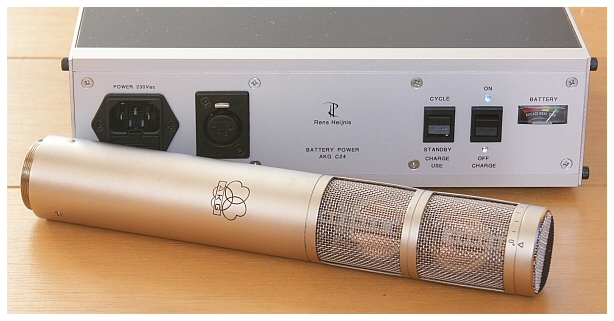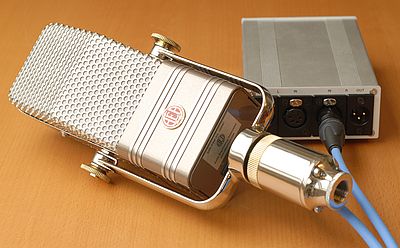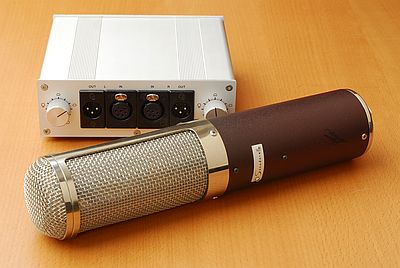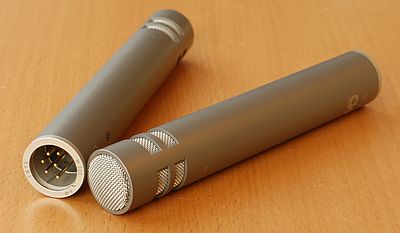 Rens Heijnis custom-built audio equipment
Rens Heijnis custom-built audio equipment
When you are not happy with the sound of your microphone.
Nowadays the microphone looks the same as 60 years ago but electronics has changed from a tube circuit with a
few components and an external power supply to a phantom powered circuit with a modern SMD board overloaded
with components. The result is a sound which is: lifeless, thin, sharp and flat.
But it is possible to retrofit your microphone with a trough-hole printed circuit board and audio components and an
external power supply.
What is wrong with a modern SMD circuit board?
Modern printed circuit boards are made with SMD components. It looks like this:

The problem with a SMD board is that the sound quality of the tiny SMD components are much worse than the old
through-hole components. Plus the SMD board is cheap an tiny, so its now possible to use much more components
and that's what manufacturers do.
Result: a circuit board with to much components which has a bad sound quality.
What is wrong with phantom power?
Phantom-fed microphones are inherently less suitable for
high-quality audio usage since they work as compressors:
when, for instance, high dynamics are required, strong demands are made on the
current supply of the phantom.
As a result, the current supply drops
drastically and the stereo image and frequency response collapse with
it.
In the block diagrams you can clearly see the difference between phantom power and active powering
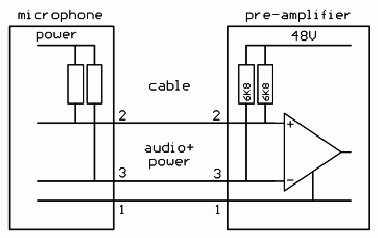

Phantom power (power and audio together) Active +60V power (power separated from the audio)
The sonic improvements of active powering are:
- clearer placement of musical instruments within the stereo sound field
- exceptionally fast reaction time to intermittent high impulse sound waves
- extreme clarity and definition of complex low frequency sounds
- measurably less distortion across the entire sound spectrum
- overall a pleasant sounding microphone
Improve the sound of your current microphone by retrofitting and active powering.
When you are not satisfied with the sound of your microphone: too sharp, strident, thin, lacking vibrancy
or anything else, it is possible to retrofit your microphone with better electronics to improve the sound.
After retrofitting your microphone has a smoother sound, less sharp and strident, more vibrancy.
Retrofitting is possible for nearly all condensator microphones such as AKG, DPA, Gefell, Neumann, Schoeps and Sanken.
A retrofitted microphone has a new printed circuit board with trough-hole components.
All the components are selected for there proven sound quality.
Some examples:

1" large diagram microphones could also be retrofitted with a tube amplifier, see section 2.
The mains power supply for active powered microphones:
No phantom power is used so an external power supply is necessary.
The normal standard is 60V with a 4 pin XLR connector.
The power supply can be made in different enclosures, see section 4
For a description of a 2 channel version see: PS-402
The battery powered power supply for active powered microphones:
It is a well known and documented fact, that battery powered audio equipment
(separated from the main voltage) sounds substantially better. There are several plausible reasons for this.
Apart from getting rid of the pollution on the main power,
also the absence of interfering ground currents
adds to the improvement also.
In the block diagrams you can clearly see the difference.
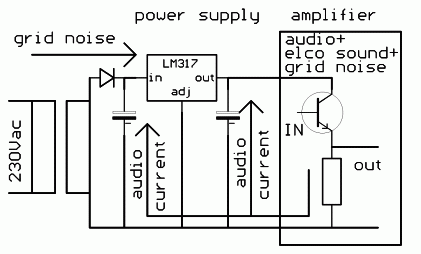
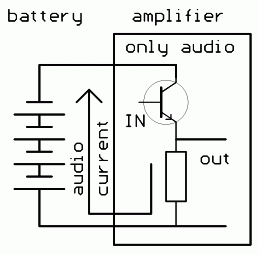
The sonic improvements due to battery powering are:
- more softness in the high frequencies
- more robustness in the low frequencies
- a much more relaxed projection of the sound images
- less noise artifacts
- faster reaction time
- an overall much more realistic and pleasant sound
For a few examples of battery powered equipment see section 3
For a description of a 2 channel version see: PSB-402
Li-ion or lead-acid batteries.
The
experiences with the modern Li-ion batteries are good:
-
5 times lighter and smaller than lead acid batteries with the same
capacity.
-
easier to charge
-
a slightly better sound quality than the lead acid batteries.
- much longer life expectense.
For a few examples of battery powered equipment see section 3
The microphone cable
A special microphone cable is neccesary between the microphone and power supply.
The standard microphone cable is a Mogami starquad cable: Mogami 2534
For the +60V norm it is supplied with 4 pin XLR connectors.
For the + -15V norm (Li-ion batteries) it is supplied with 6 pin XLR connectors.
Every cable length is available.
The output of the power supply is a normal 3 pin XLR.
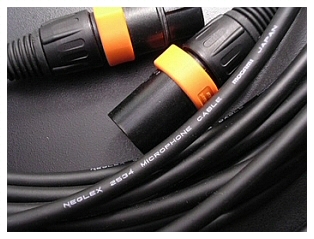
For microphone cables with an other sound than the Mogami see: Microphone Cables
1) A few examples of retrofitted microphones with active power
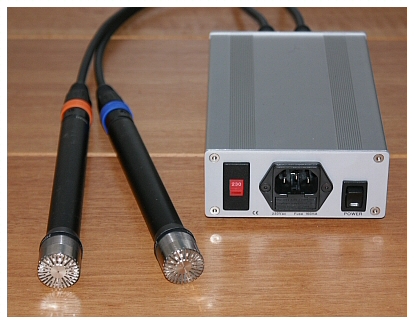
DPA4041 phantom modified to active powered.
2 channel power supply with 60V and 200V capsule voltage.
With Black Gate capacitor and other components selected for there sound quality.
2) Retrofitting of microphones now also possible with a tube amplifier.
Retrofitting your microphone is also possible with a tube amplifier.
For the engineer who likes the sound of a tube: a special low noise pre-amplifier with a tube
has been designed to install in microphones with a large diagram.
Due to the tube limitations (noise and input capacity) only possible for large diagram microphones.
The microphone will be supplies with a new power supply such as (in case of a double diagram):
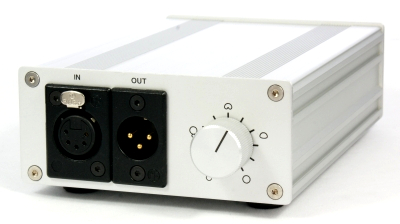
3) A few examples of battery powered (tube) microphones
Battery power for the AKG C24 tube microphone. Output voltage: 120V, weight: 5,3kg.
The original power supply will be used for the heater voltage and pattern control.
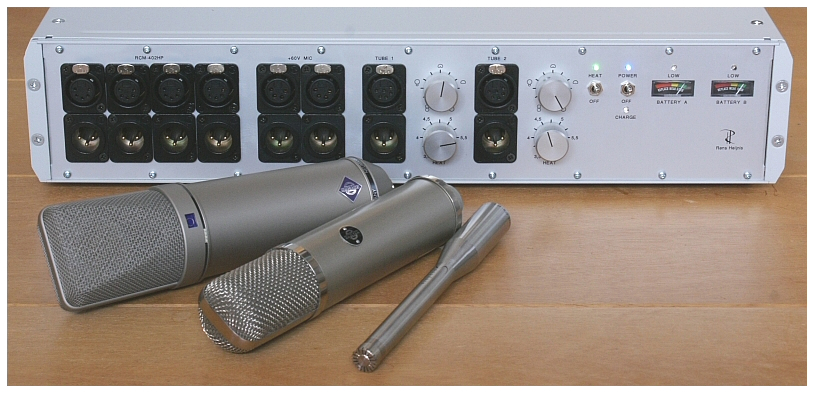
Battery power for Sonodore RCM-402HP, +60V microphones and Neumann tube microphones
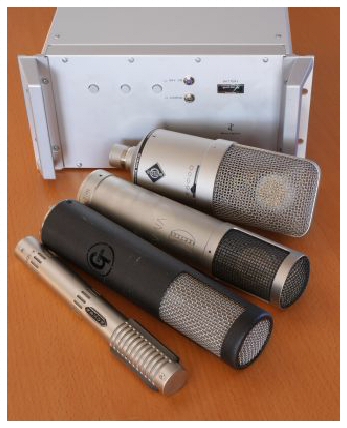
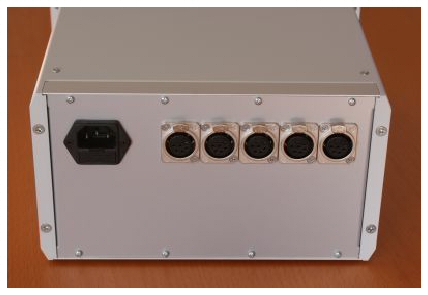
Battery power for Brauner, Groove tube, Neumann and Royer microphones .
The original power supply of the microphone has to be modified with a switch (internal-external power) and a connector
for connecting with the battery powered supply. The original power supply will be used for the heater voltage and output transformer.
Depending on the type of microphone you can use the batteries 1 to 4 days before you need to recharge them.
4) A few examples of different power supplies(+60V) for active microphones
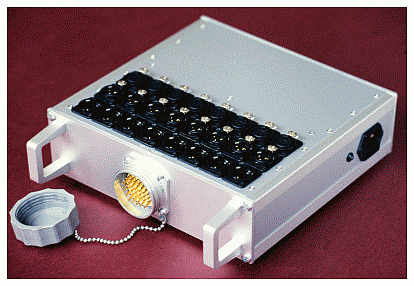
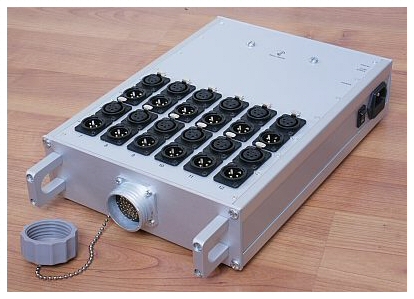
8 channel stage box with 8 power supplies 12 channel stage box.
For powering of microphones on the stage. With Socapex connector for multi-cables.
Can be supplied with battery power.

12 channel active power supply (+60V) for active powered microphones:
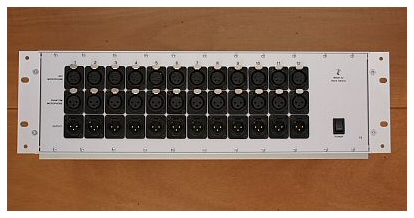
12 channel active power supply.
5) A few examples of modifications to microphones:

Retrofitted Flea47 tube.
After modification the microphone has a undistorted high,
sounds less aggressive, more vivid and natural

Retrofitted RODE NTR
This microphone can sound much warmer, more detailed
and have a more
pleasant sound after retrofitting.
The build in phantom powered PCB is very restrictive.
Retrofitted AEA A440 ribbon microphone.
Retrofitted Nevaton 404 and 416.
Nevaton is probably not so well known, but they are pretty
good capsules and worth to retrofit.
Complete retrofit of a stereo Beesneez microphone. Retrofitted Gefell M300
Only the house has been used.
Retrofit with 2 Neumann K47 capsules and a tube amplifier.
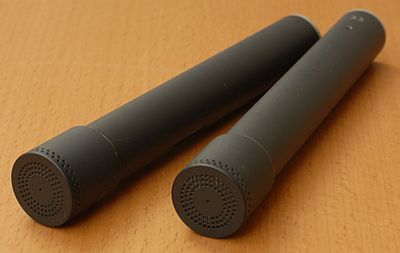
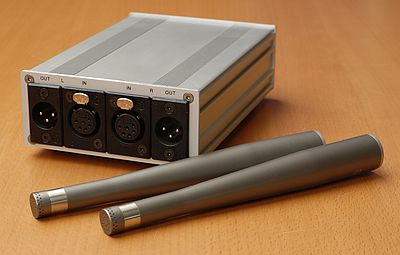
Gefell M296. Gefell MV225.
A surprisingly good microphone after retrofitting. A surprisingly good microphone after retrofitting.
Before modification it sounds very dull. Before modification it sounds very dull and lifeless
Retrofitting for 48V phantom and active 60V possible.
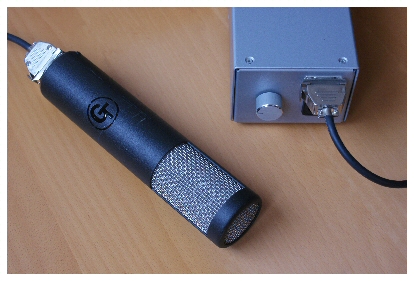
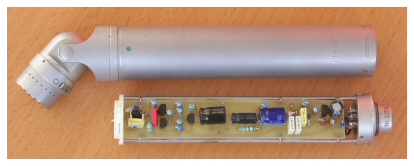
Modified Groove Tube microphone: the anode voltage of Philips EL6050/ Schoeps CM61 with a modern phantom
the tube is now adjustable. powered PCB.
The sound is changed from sluggish to responsive
Price list retrofitting microphones


















